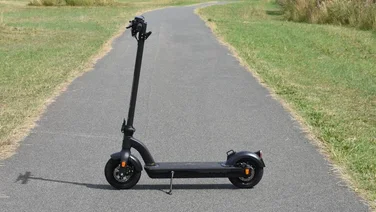To help us provide you with free impartial advice, we may earn a commission if you buy through links on our site. Learn more




The Mio Cyclo 300 is one of the first cycle GPS units from the company best known for its NavMan range of car satnavs and GPS devices. It’s a really well made bit of hardware, with a reinforced IPX7 weatherproof body that survived with just a little surface damage even after an impact and stood up well to the soggiest weather the British summer had to throw at it. Its battery life’s good too – Mio quotes up to 12 hours’ continuous use – we used it for well over nine hours in the course of a week before the battery indicator got low enough to make us feel that a recharge was advisable.

We liked the handlebar mount, too. Rather than relying on plastic clips of the sort commonly used on lights and the like, the Cyclo has a grippy rubber disc that fits into a socket at the back of the GPS unit and is held on to your handlebars by a cable tie. The main body of the GPS unit clicks securely into place. With the cable tie properly tightened, the mount feels much more secure than traditional clips and is somewhat more forgiving when it comes to tapered handlebars too. However, we opted to attach it to our stem, where it fitted securely, slipping only in a torrential downpour – even then, the unit as a whole remained safely attached to our bike.
The touchscreen display is a little more reflective than we’d like, but its anti-glare shield means that it was still possible to view in all but the brightest direct sunlight. Keeping your eyes fixed on a satnav while you’re cycling isn’t the brightest idea, though, so the Cyclo provides you with voice cues when you reach junctions.
The main screen is occupied by six cheerfully colourful touch buttons. One activates the Dashboard, our favourite feature, which allows you to track and record your route, speed, total active time, elevation and more. The Navigate screen is where you ask the Cyclo to plan your route, either for car or bicycle. It lets you enter your home address as a shortcut and also has an address book for any other address you choose to enter. Entering address data is made easy by alphanumeric touchscreen keypads that won’t let you enter any address that isn’t in your installed map set – in this case, a 22-region Western European map set.

We found that the database doesn’t recognise some valid postcodes and as a result won’t let you enter them. However, once you start typing in a street name, it’ll ask to you choose from a list as soon as you’ve entered enough for it to create a shortlist of options. It’s worth noting that you can only calculate routes of under 200km in distance – that’s long enough for most cyclists, but more adventurous cycle tourists may have to divide their journeys into sections because of this.
You can also choose to visit local places of interest including restaurants, bicycle shops, cashpoints and medical services. We found the list for our local areas of London to be fairly comprehensive and rather handy. There’s also a Tracks option, which lets you navigate on- or off-road routes you’ve previously created using the Mio Share web interface.
Other buttons take you to a log of rides you’ve previously recorded, ask the GPS to surprise you with a random route of a specified distance or time. An in-depth settings menu lets you choose between Ordinance Survey and TeleAtlas map displays, configure the screen’s brightness and set details such as your preferred units of measurement.

The navigation screen shows you where you are on the map and the direction in which you need to travel, but because the map is closely zoomed in order to be visible, it can be hard to get a sense of your surroundings. We’re not too keen on its approach to roundabouts though – instead of telling us to “take the third exit”, we were instead repeatedly told to make a “slight right” until we reached the exit we needed. Another problem here is that sometimes the GPS wasn’t able to track our movement fast enough, leading us to miss turns when moving at speed. Central London, with its quirky one-way systems and unpredictable road-works, is always a challenge for any navigation tool, but the Cyclo became inordinately lost when trying to navigate our way through Soho.
The GPS then whines at you for going the wrong way until you turn around, but does eventually give in and attempt to plot you a new route as you’re moving. It also took its time when it came to initially locking on to a GPS signal, although this is a fairly common problem if you’re in a city with a lot of overhanging buildings. Beyond these issues, the Cyclo 300 simply isn’t very good at plotting effective cycle routes, routinely ignoring streets with cycle lanes in favour of those which lack such infrastructure, being entirely unaware of most off-road cycle paths and sending us up routes which are both steeper and longer than necessary to get to our destination without giving us any opportunity to choose between alternative options, in the way Google Maps does.
The PC interface for the Cyclo isn’t great either. Although you can install a desktop app that’s stored on the Cyclo itself, it’s basically a front end for Internet Explorer that takes you to the MioShare web site. The web-based application itself relies on IE and ActiveX if you use Windows. A Mac equivalent is also available, but support for other browsers hasn’t been implemented. It takes ages to transfer even a handful of recorded journeys to MioShare, as it’s not just a matter of dumping the data to your PC – it has to be uploaded, too. If, like us, you make a lot of journeys before connecting the Cyclo to MioShare, you’ll have a long wait while all the data is transferred.
Whether uploaded or on the device, clicking into a journey’s entry – helpfully named by date and time – allows you to view your route in a Google Maps window, provides you with an elevation graph and data including your average and maximum speeds, total altitude gained and so on. While all this information is interesting, there’s not very much you can do with it and there are no options for exporting data to other services such as RunKeeper. You can’t even export a ride route as a track for future use.
You can use the MioShare interface to manually create tracks to follow, though, which you can then upload to your GPS unit to follow in future. The tracks mapping screen defaults to Mio’s Belgian homeland but leapt us to London as soon as we entered our post code. There are a few options you can use while plotting your route, including a manual planner that lets you place route nodes anywhere – handy if you want to go across country – and node-based planning, which finds the best road route between the nodes you place, although this didn’t always work, leaving us waiting indefinitely for the route to be mapped.
There are also two modes which instruct the track creator to automatically plot the best bike route to your destination, either including or not including unpaved pathways. This didn’t always work out as well as we might have hoped – like the Mio’s integrated route planner, the online version isn’t aware of important British cycle infrastructure such as the National Cycle Networks and for some unknown reason advised us to take a terrifying (and forbidden to cyclists) roundabout where the A1M crosses the M25. You can’t change the tracks mapped by these point-to-point features, either, which takes us back to node-based routing as the most practical option, given the planner’s minimal grasp of what a cycle path is, let alone where to find one.

The Cyclo 300 is a great little dashboard and tracker but its ability to plot cycle-friendly routes is less than ideal. We also had issues with its accuracy in tracking our location relative to the next turn and we disliked the way it handles roundabouts. While occasional drop-outs in GPS accuracy as probably down the inherent problems of using GPS in a densely built-up city, the other issues can all be fixed by firmware updates. When and if they are, the Cyclo 300 will be a great riding companion, but for now its high-quality hardware is let down by the limitations of its firmware.
At £234, it’s also rather expensive given its limited range of features. There’s a more sophisticated version, the Cyclo 305, which includes heart rate monitoring and cadence sensing features, but we’d still recommend shelling out an extra £32 on the outstanding Garmin Edge 800 cycle GPS instead.





